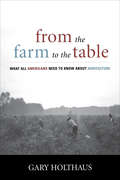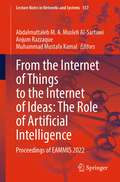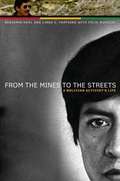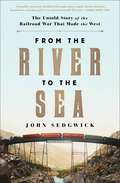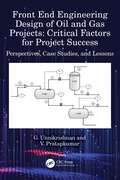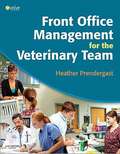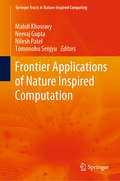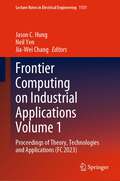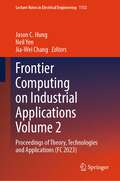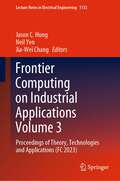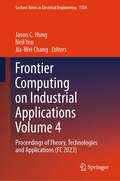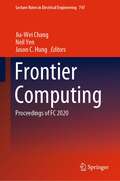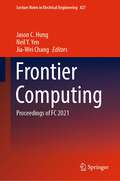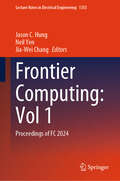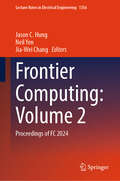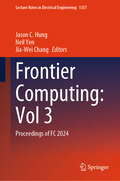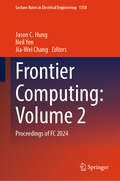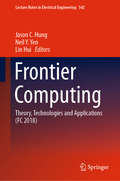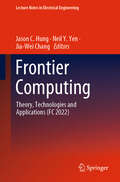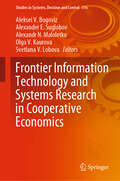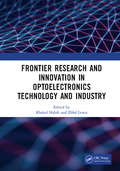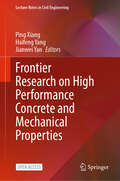- Table View
- List View
From the Farm to the Table: What All Americans Need to Know about Agriculture (Culture of the Land)
by Gary HolthausA portrait of the realities of agricultural life in today&’s world, based on interviews with more than forty farm families. In this book, dozens of farm families from America&’s heartland detail the practices and values that relate to their land, work, and communities. Their stories reveal that those who make their living in agriculture—despite stereotypes of provincialism perpetuated by the media—are savvy to the influence of world politics on local issues. Gary Holthaus demonstrates how outside economic, governmental, legal, and business developments play an increasingly influential, if not controlling, role in every farmer&’s life. The swift approval of genetically modified crops by the federal government, the formation of huge agricultural conglomerates, and the devastating environmental effects of chemical fertilizers, pesticides, and herbicides are just a few issues buffeting family farms. From the Farm to the Table explores farmers&’ experiences to offer a deeper understanding of how we can create sustainable and vibrant land-based communities by adhering to fundamental agrarian values. &“Tells the story of modern agriculture through engaging interviews with men and women who make a living farming in southeastern Minnesota. In a tone reminiscent of Wendell Berry&’s A Place on Earth, he examines the far-reaching effects of genetically modified organisms, free-trade agreements that nurture &‘transnational corporate profit,&’ dependence on fossil fuel-derived chemicals, and the toll all this has taken on the land and farmers.&” —Library Journal
From the Internet of Things to the Internet of Ideas: Proceedings of EAMMIS 2022 (Lecture Notes in Networks and Systems #557)
by Muhammad Mustafa Kamal Anjum Razzaque Abdalmuttaleb M. A. Musleh Al-SartawiThis book shows latest research on the role Artificial inelegance in enabling IoT to evoke IoI, and how IoI flourish inside technologies like social media platforms, social networks: communities of practice/interest, to assure a globally sustainable unit where humans integrate with machines to collaboratively share ideas and solve complex problems. Such a book holds several benefits. It will reveal theoretical practical, and managerial implications through discussions that will embrace a wide array of technologies focused on the role of AI enabled IoT to evoke IoI. EAMMIS 2022 was organized by the Bridges Foundation in cooperation with Coventry University, UK on the 10th and 11th of June 2022. EAMMIS 2022 theme was From the Internet of Things to the Internet of Ideas: The role of Artificial Intelligence. The papers presented at the conference provide a holistic view of AI and its applications, IOT and the IOI which will help societies to better use and benefit from AI, IOT and IOI to develop future strategies and actions.
From the Mines to the Streets
by Benjamin Kohl Linda Farthing Félix MuruchiFrom the Mines to the Streets draws on the life of Félix Muruchi to depict the greater forces at play in Bolivia and elsewhere in South America during the last half of the twentieth century. It traces Félix from his birth in an indigenous family in 1946, just after the abolition of bonded labor, through the next sixty years of Bolivia’s turbulent history. As a teenager, Félix followed his father into the tin mines before serving a compulsory year in the military, during which he witnessed the 1964 coup d’état that plunged the country into eighteen years of military rule. He returned to work in the mines, where he quickly rose to become a union leader. The reward for his activism was imprisonment, torture, and exile. After he came home, he participated actively in the struggles against neoliberal governments, which led in 2006—the year of his sixtieth birthday—to the inauguration of Evo Morales as Bolivia’s first indigenous president. The authors weave Muruchi’s compelling recollections with contextual commentary that elucidates Bolivian history. The combination of an unforgettable life story and in-depth text boxes makes this a gripping, effective account, destined to become a classic sourcebook.
From the Plate to Gastro-Politics: Unravelling the Boom of Peruvian Cuisine (Food and Identity in a Globalising World)
by Raúl MattaThis book provides an interdisciplinary examination of Peruvian cuisine’s shift from a culinary to a political object and the making of Peru as a food nation on the global stage. It focuses on the contexts, processes and protagonists that have endowed the country’s cuisine with new meaning, new coherence and prominence, and with the ability to communicate what was important for Peruvians after decades of political violence and economic decline. This work unfolds central processes of the culinary project ranging from the emergence of gastronomy, to the refiguring of indigenous people as producers, to the use of cultural identity as an authenticating force. From the Plate to Gastro-Politics offers a critical reading of what has been called a “gastronomic revolution”, highlighting the ways in which claims to national unity and social reconciliation smooth over ongoing inequalities. This book will be of interest to scholars and students of food studies, cultural anthropology, heritage studies and Latin American studies.
From the River to the Sea: The Untold Story of the Railroad War That Made the West
by John SedgwickA sweeping and lively history of one of the most dramatic stories never told—of the greatest railroad war of all time, fought by the daring leaders of the Santa Fe and the Rio Grande to seize, control, and create the American West. It is difficult to imagine now, but for all of its cloudy peaks and gorgeous coastline, the American West might have been barren tundra as far as most Americans knew well into the 19th century. While gauzy advertising promotions of the West as a paradise on earth intrigued citizens in the East and Midwest, many believed the journey too hazardous to be worthwhile—until 1869, when the first transcontinental railroad changed the face of transportation. Railroad companies soon became the rulers of western expansion, choosing routes, creating brand-new railroad towns, and building up remote settlements like Santa Fe, Albuquerque, San Diego, and El Paso into proper cities. But thinning federal grants left the routes incomplete, an opportunity that two brash new railroad men, armed with private investments and determination to build an empire across the Southwest clear to the Pacific, soon seized, leading to the greatest railroad war in American history. In From the River to the Sea, bestselling author John Sedgwick recounts, in vivid and thrilling detail, the decade-long fight between General William J. Palmer, the Civil War hero leading the &“little family&” of his Rio Grande, coming down from Denver, hoping to showcase the majesty of the Rockies, and William Barstow Strong, the hard-nosed manager of the corporate-minded Santa Fe, venturing west from Kansas. What begins as an accidental rivalry when the two lines cross in Colorado soon evolves into an all-out battle as each man tries to outdo the other—claiming exclusive routes through mountains, narrow passes, and the richest silver mines in the world; enlisting private armies to protect their land and lawyers to find loopholes; dispatching spies to gain information; and even using the power of the press and incurring the wrath of the God-like Robber Baron Jay Gould—to emerge victorious. By the end of the century, one man will fade into anonymity and disgrace. The other will achieve unparalleled success—and in the process, transform a sleepy backwater of thirty thousand called &“Los Angeles&” into a booming metropolis that will forever change the United States. Filled with colorful characters and high drama, told at the speed of a locomotive, From the River to the Sea is an unforgettable piece of American history—and one of the last great untold tales of the Wild West.
Front End Engineering Design of Oil and Gas Projects: Perspectives, Case Studies, and Lessons
by G. Unnikrishnan V. PratapkumarQuite a large number of major oil and gas projects are failures with respect to their costs, schedules, and operational performance. Owner companies and contractors are struggling with the issues causing these failures. The Front End Engineering Design (FEED) has been identified as an important factor that plays a key role in determining the success of a project. However, the FEED and the associated Front End Loading (FEL) do not get the attention they deserve from the players in the business, namely, the owner companies, FEED, and EPC contractors. While academic studies on the FEL and its failures are available, how the seeds of failures are sown during an actual project FEED remains a mystery. The details are usually buried in the rubbished computers and hundreds of files that are shelved in companies' offices. In this unique book, two experienced professionals, one from an owner company and the other from an international EPC contractor, whose interests often oppose each other, join to give their perspectives about the project lifecycle, its governance structure, gate system, complexities, contract models, and quality measurements. In the second part of the book, they present case studies of projects gone wrong, due to mismatches, errors, and inconsistencies in the FEED. These case histories reveal how avoidable gaps and errors creep into FEED resulting in project failures and how the review systems fail to detect them. Technical and business professionals seem to underestimate the importance of FEED in capital-intensive major projects, while focusing on short-term goals. The underlying causal factors need to be addressed and resolved in time properly, for ensuring success of major oil and gas projects. Written in a concise and practical style, with key takeaways at the end of each chapter, this book will be a useful guide for practicing project and engineering professionals in the oil and gas industry. Senior students and researchers will find ideas and viewpoints given in this book worth exploring further.
Front Office Management for The Veterinary Team: 3rd Edition
by Heather PrendergastLearn to navigate the day-to-day skills you need to be a valuable member of the veterinary office team! Front Office Management for the Veterinary Team, 3rd Edition covers veterinary office duties ranging from: scheduling appointments to billing and accounting, managing inventory and medical records, marketing, using outside diagnostic laboratory services, and communicating effectively and compassionately with clients. This edition includes two all-new chapters on strategic planning and leadership, updated coverage of office procedures, veterinary ethics, and technology. In addition, this complete guide to veterinary practice management features step-by-step instructions, making it easier for you to master vital front-office tasks!
Front Office Management for the Veterinary Team
by Heather PrendergastThe only book of its kind, Front Office Management for the Veterinary Team focuses on the day-to-day duties of the veterinary team. It offers a complete guide to scheduling appointments, billing and accounting, communicating effectively and compassionately with clients, managing medical records, budgeting, marketing your practice, managing inventory, using outside diagnostic laboratory services, and much more. Written by Heather Prendergast, RVT, CVPM, this manual simplifies essential tasks with step-by-step instructions! Exercises on the Evolve website offer additional practice with front office tasks. Interactive working forms give you experience completing sample checks, deposit slips, patient history forms, and incident reports. The latest information on electronic banking and tax forms ensures that you adhere to the most current financial guidelines. What Would You Do/Not Do boxes provide scenarios to expose you to real-life situations that occur in veterinary practice and guide you through to an appropriate resolution. Review questions test your understanding of concepts presented in each chapter. Practice Point boxes highlight practical information to remember while on the job. Veterinary Practice and the Law boxes provide essential information about laws that you must know in order to run an ethical practice and to protect the practice. Key terms and learning objectives guide you through study of the most important content.
Frontier Applications of Nature Inspired Computation (Springer Tracts in Nature-Inspired Computing)
by Neeraj Gupta Tomonobu Senjyu Mahdi Khosravy Nilesh PatelThis book addresses the frontier advances in the theory and application of nature-inspired optimization techniques, including solving the quadratic assignment problem, prediction in nature-inspired dynamic optimization, the lion algorithm and its applications, optimizing the operation scheduling of microgrids, PID controllers for two-legged robots, optimizing crane operating times, planning electrical energy distribution systems, automatic design and evaluation of classification pipelines, and optimizing wind-energy power generation plants. The book also presents a variety of nature-inspired methods and illustrates methods of adapting these to said applications. Nature-inspired computation, developed by mimicking natural phenomena, makes a significant contribution toward the solution of non-convex optimization problems that normal mathematical optimizers fail to solve. As such, a wide range of nature-inspired computing approaches has been used in multidisciplinary engineering applications. Written by researchers and developers from a variety of fields, this book presents the latest findings, novel techniques and pioneering applications.
Frontier Computing on Industrial Applications Volume 1: Proceedings of Theory, Technologies and Applications (FC 2023) (Lecture Notes in Electrical Engineering #1131)
by Jason C. Hung Neil Yen Jia-Wei ChangThis book gathers the proceedings of the 13th International Conference on Frontier Computing, held in Tokyo, on July 10–13, 2023, and provides comprehensive coverage of the latest advances and trends in information technology, science, and engineering. It addresses a number of broad themes, including communication networks, business intelligence and knowledge management, Web intelligence, and related fields that inspire the development of information technology. The respective contributions cover a wide range of topics: database and data mining, networking and communications, Web and Internet of things, embedded systems, soft computing, social network analysis, security and privacy, optical communication, and ubiquitous/pervasive computing. Many of the papers outline promising future research directions, and the book benefits students, researchers, and professionals alike. Further, it offers a useful reference guide for newcomers to the field.
Frontier Computing on Industrial Applications Volume 2: Proceedings of Theory, Technologies and Applications (FC 2023) (Lecture Notes in Electrical Engineering #1132)
by Jason C. Hung Neil Yen Jia-Wei ChangThis book gathers the proceedings of the 13th International Conference on Frontier Computing, held in Tokyo, on July 10–13, 2023, and provides comprehensive coverage of the latest advances and trends in information technology, science, and engineering. It addresses a number of broad themes, including communication networks, business intelligence and knowledge management, Web intelligence, and related fields that inspire the development of information technology. The respective contributions cover a wide range of topics: database and data mining, networking and communications, Web and Internet of things, embedded systems, soft computing, social network analysis, security and privacy, optical communication, and ubiquitous/pervasive computing. Many of the papers outline promising future research directions, and the book benefits students, researchers, and professionals alike. Further, it offers a useful reference guide for newcomers to the field.
Frontier Computing on Industrial Applications Volume 3: Proceedings of Theory, Technologies and Applications (FC 2023) (Lecture Notes in Electrical Engineering #1133)
by Jason C. Hung Neil Yen Jia-Wei ChangThis book gathers the proceedings of the 13th International Conference on Frontier Computing, held in Tokyo, on July 10–13, 2023, and provides comprehensive coverage of the latest advances and trends in information technology, science, and engineering. It addresses a number of broad themes, including communication networks, business intelligence and knowledge management, Web intelligence, and related fields that inspire the development of information technology. The respective contributions cover a wide range of topics: database and data mining, networking and communications, Web and Internet of things, embedded systems, soft computing, social network analysis, security and privacy, optical communication, and ubiquitous/pervasive computing. Many of the papers outline promising future research directions, and the book benefits students, researchers, and professionals alike. Further, it offers a useful reference guide for newcomers to the field.
Frontier Computing on Industrial Applications Volume 4: Proceedings of Theory, Technologies and Applications (FC 2023) (Lecture Notes in Electrical Engineering #1134)
by Jason C. Hung Neil Yen Jia-Wei ChangThis book gathers the proceedings of the 13th International Conference on Frontier Computing, held in Tokyo, on July 10–13, 2023, and provides comprehensive coverage of the latest advances and trends in information technology, science, and engineering. It addresses a number of broad themes, including communication networks, business intelligence and knowledge management, Web intelligence, and related fields that inspire the development of information technology. The respective contributions cover a wide range of topics: database and data mining, networking and communications, Web and Internet of things, embedded systems, soft computing, social network analysis, security and privacy, optical communication, and ubiquitous/pervasive computing. Many of the papers outline promising future research directions, and the book benefits students, researchers, and professionals alike. Further, it offers a useful reference guide for newcomers to the field.
Frontier Computing: Proceedings of FC 2020 (Lecture Notes in Electrical Engineering #747)
by Jason C. Hung Neil Yen Jia-Wei ChangThis book gathers the proceedings of the 10th International Conference on Frontier Computing, held in Singapore, on July 10–13, 2020, and provides comprehensive coverage of the latest advances and trends in information technology, science, and engineering. It addresses a number of broad themes, including communication networks, business intelligence and knowledge management, web intelligence, and related fields that inspire the development of information technology. The respective contributions cover a wide range of topics: database and data mining, networking and communications, web and Internet of things, embedded systems, soft computing, social network analysis, security and privacy, optical communication, and ubiquitous/pervasive computing. Many of the papers outline promising future research directions, and the book benefits students, researchers, and professionals alike. Further, it offers a useful reference guide for newcomers to the field.
Frontier Computing: Proceedings of FC 2021 (Lecture Notes in Electrical Engineering #827)
by Neil Y. Yen Jason C. Hung Jia-Wei ChangThis book gathers the proceedings of the 11th International Conference on Frontier Computing, held in Seoul, on July 13–17, 2021, and provides comprehensive coverage of the latest advances and trends in information technology, science, and engineering. It addresses a number of broad themes, including communication networks, business intelligence and knowledge management, Web intelligence, and related fields that inspire the development of information technology. The respective contributions cover a wide range of topics: database and data mining, networking and communications, Web and Internet of things, embedded systems, soft computing, social network analysis, security and privacy, optical communication, and ubiquitous/pervasive computing. Many of the papers outline promising future research directions, and the book benefits students, researchers, and professionals alike. Further, it offers a useful reference guide for newcomers to the field.
Frontier Computing: Proceedings of FC 2024 (Lecture Notes in Electrical Engineering #1355)
by Jason C. Hung Neil Yen Jia-Wei ChangThis book covers issues of computer science, application on cloud computing, information security and describes applications of frontier computing. Frontier Computing conference aims at providing an open forum to reach a comprehensive understanding to the recent advances and emergence in information technology, science, and engineering, with the themes in the scope of Communication Network, Business Intelligence and Knowledge Management, Web Intelligence, and any related fields that prompt the development of information technology. Articles cover a wide spectrum of topics: database and data mining, networking and communications, web and internet of things, embedded system, soft computing, social network analysis, security and privacy, optics communication, and ubiquitous/pervasive computing. Many papers have shown their great academic potential and value, and in addition, indicate promising directions of research in the focused realm of this conference series. Readers who will benefit from this comprehensive overview of the latest in information technology include students, researchers, and industry professionals in the fields of cloud computing, internet of things, machine learning, information security, multimedia systems, information technology, and so on. The book also serves as a comprehensive overview for young investigators looking to start a new research program.
Frontier Computing: Proceedings of FC 2024 (Lecture Notes in Electrical Engineering #1356)
by Jason C. Hung Neil Yen Jia-Wei ChangThis book covers issues of computer science, application on cloud computing, information security and describes applications of frontier computing. Frontier Computing conference aims at providing an open forum to reach a comprehensive understanding to the recent advances and emergence in information technology, science, and engineering, with the themes in the scope of Communication Network, Business Intelligence and Knowledge Management, Web Intelligence, and any related fields that prompt the development of information technology. Articles cover a wide spectrum of topics: database and data mining, networking and communications, web and internet of things, embedded system, soft computing, social network analysis, security and privacy, optics communication, and ubiquitous/pervasive computing. Many papers have shown their great academic potential and value, and in addition, indicate promising directions of research in the focused realm of this conference series. Readers who will benefit from this comprehensive overview of the latest in information technology include students, researchers, and industry professionals in the fields of cloud computing, internet of things, machine learning, information security, multimedia systems, information technology, and so on. The book also serves as a comprehensive overview for young investigators looking to start a new research program.
Frontier Computing: Proceedings of FC 2024 (Lecture Notes in Electrical Engineering #1357)
by Jason C. Hung Neil Yen Jia-Wei ChangThis book covers issues of computer science, application on cloud computing, information security and describes applications of frontier computing. Frontier Computing conference aims at providing an open forum to reach a comprehensive understanding to the recent advances and emergence in information technology, science, and engineering, with the themes in the scope of Communication Network, Business Intelligence and Knowledge Management, Web Intelligence, and any related fields that prompt the development of information technology. Articles cover a wide spectrum of topics: database and data mining, networking and communications, web and internet of things, embedded system, soft computing, social network analysis, security and privacy, optics communication, and ubiquitous/pervasive computing. Many papers have shown their great academic potential and value, and in addition, indicate promising directions of research in the focused realm of this conference series. Readers who will benefit from this comprehensive overview of the latest in information technology include students, researchers, and industry professionals in the fields of cloud computing, internet of things, machine learning, information security, multimedia systems, information technology, and so on. The book also serves as a comprehensive overview for young investigators looking to start a new research program.
Frontier Computing: Proceedings of FC 2024 (Lecture Notes in Electrical Engineering #1358)
by Jason C. Hung Neil Yen Jia-Wei ChangThis book covers issues of computer science, application on cloud computing, information security and describes applications of frontier computing. Frontier Computing conference aims at providing an open forum to reach a comprehensive understanding to the recent advances and emergence in information technology, science, and engineering, with the themes in the scope of Communication Network, Business Intelligence and Knowledge Management, Web Intelligence, and any related fields that prompt the development of information technology. Articles cover a wide spectrum of topics: database and data mining, networking and communications, web and internet of things, embedded system, soft computing, social network analysis, security and privacy, optics communication, and ubiquitous/pervasive computing. Many papers have shown their great academic potential and value, and in addition, indicate promising directions of research in the focused realm of this conference series. Readers who will benefit from this comprehensive overview of the latest in information technology include students, researchers, and industry professionals in the fields of cloud computing, internet of things, machine learning, information security, multimedia systems, information technology, and so on. The book also serves as a comprehensive overview for young investigators looking to start a new research program.
Frontier Computing: Theory, Technologies and Applications (FC 2018) (Lecture Notes in Electrical Engineering #542)
by Neil Y. Yen Jason C. Hung Lin HuiThis book presents the proceedings of the 6th International Conference on Frontier Computing, held in Kuala Lumpur, Malaysia on July 3–6, 2018, and provides comprehensive coverage of the latest advances and trends in information technology, science and engineering. It addresses a number of broad themes, including communication networks, business intelligence and knowledge management, web intelligence, and related fields that inspire the development of information technology. The contributions cover a wide range of topics: database and data mining, networking and communications, web and internet of things, embedded systems, soft computing, social network analysis, security and privacy, optical communication, and ubiquitous/pervasive computing. Many of the papers outline promising future research directions. The book is a valuable resource for students, researchers and professionals, and also offers a useful reference guide for newcomers to the field.
Frontier Computing: Theory, Technologies and Applications (FC 2019) (Lecture Notes in Electrical Engineering #551)
by Neil Y. Yen Jason C. Hung Jia-Wei ChangThis book gathers the proceedings of the 9th International Conference on Frontier Computing, held in Kyushu, Japan on July 9–12, 2019, and provides comprehensive coverage of the latest advances and trends in information technology, science and engineering. It addresses a number of broad themes, including communication networks, business intelligence and knowledge management, web intelligence, and related fields that inspire the development of information technology. The respective contributions cover a wide range of topics: database and data mining, networking and communications, web and internet of things, embedded systems, soft computing, social network analysis, security and privacy, optical communication, and ubiquitous/pervasive computing. Many of the papers outline promising future research directions, and the book will benefit students, researchers and professionals alike. Further, it offers a useful reference guide for newcomers to the field.
Frontier Computing: Theory, Technologies and Applications (FC 2022) (Lecture Notes in Electrical Engineering #1031)
by Neil Y. Yen Jason C. Hung Jia-Wei ChangThis book gathers the proceedings of the 12th International Conference on Frontier Computing, held in Tokyo, Japan, on July 12–15, 2022, and provides comprehensive coverage of the latest advances and trends in information technology, science, and engineering. It addresses a number of broad themes, including communication networks, business intelligence and knowledge management, Web intelligence, and related fields that inspire the development of information technology. The respective contributions cover a wide range of topics: database and data mining, networking and communications, Web and Internet of things, embedded systems, soft computing, social network analysis, security and privacy, optical communication, and ubiquitous/pervasive computing. Many of the papers outline promising future research directions, and the book benefits students, researchers, and professionals alike. Further, it offers a useful reference guide for newcomers to the field.
Frontier Information Technology and Systems Research in Cooperative Economics (Studies in Systems, Decision and Control #316)
by Aleksei V. Bogoviz Alexander E. Suglobov Alexandr N. Maloletko Olga V. Kaurova Svetlana V. LobovaThis book is the very first book-length study devoted to the advances in technological development and systems research in cooperative economics. The chapters provide, first of all, a coherent framework for understanding and applying the concepts and approaches of complexity and systems science for the advanced study of cooperative networks and particular cooperative enterprises and communities. Second, the book serves as a unique source of reliable information on the frontier information technologies available for the production, consumer, credit, and agricultural cooperative enterprises, discussing predominant strategies, potential drivers of change, and responses to complex problems. Given the diverse range of backgrounds and advanced research results, researchers, decision-makers, and stakeholders from all fields of cooperative economics in any country of the world will undoubtedly benefit from this book.
Frontier Research and Innovation in Optoelectronics Technology and Industry: Proceedings of the 11th International Symposium on Photonics and Optoelectronics (SOPO 2018), August 18-20, 2018, Kunming, China
by Khaled Habib Elfed LewisThis book provides an overview of research achievements by industry experts and academic scientists in the subject area of Optoelectronics Technology and Industry. It covers a broad field ranging from Laser Technology and Applications, Optical Communications, Optoelectronic Devices and Integration, Energy Harvesting, to Medical and Biological Applications. Authored by highly-regarded researchers, contributing a wealth of knowledge on Photonics and Optoelectronics, this comprehensive collection of papers offers insight into innovative technologies, recent advances and future trends needed to develop effective research and manage projects. Researchers will benefit considerably when applying the technical information covered in this book.
Frontier Research on High Performance Concrete and Mechanical Properties (Lecture Notes in Civil Engineering #518)
by Ping Xiang Haifeng Yang Jianwei YanThis open access book focuses on cutting-edge research in high-performance concrete. Concrete has been a main construction material all over the world in the past century. As the demand for construction rises, the need for concrete with stronger performance grows as well. Existing studies on high-performance concrete are mainly on fiber admixtures and reactive mineral powder admixtures, with a focus on concrete proportioning and rheological properties. Through in-depth analysis of real-world engineering cases and demonstration of the latest research achievements, this book aims to provide a systematic review of research on high-performance concrete for civil engineers and scholars in related research fields. The topics of this book include but are not limited to the following: 1. Fiber Reinforced Concrete and Admixture Factors; 2. Effect of Mineral Reactive Powders on Concrete; 3. High Performance Concrete Packing Density and Rheological Properties; 4. High Performance Concrete Proportioning and Theoretical Research; 5. Research on Mechanical Properties of High Performance Concrete.
